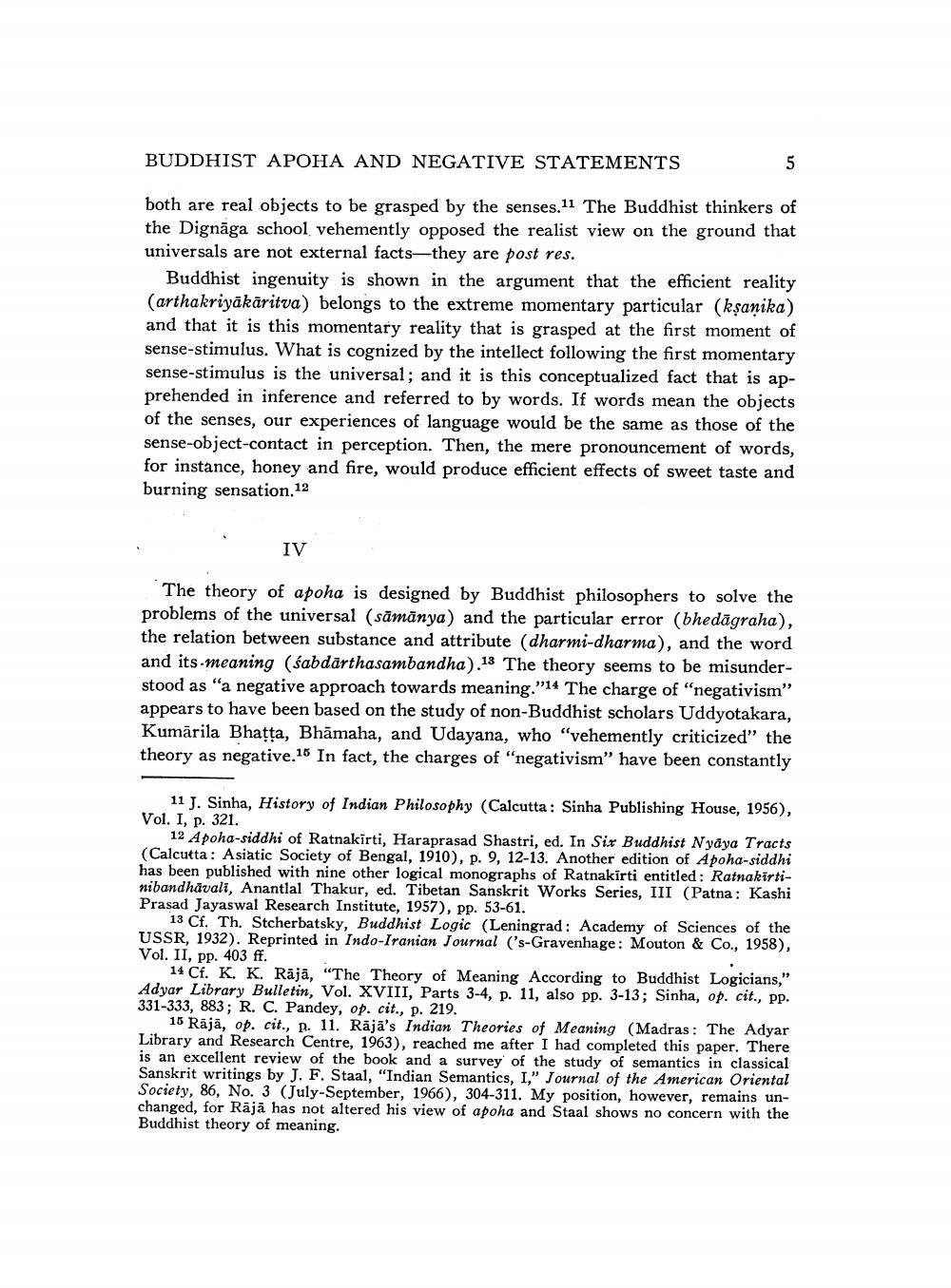________________
BUDDHIST APOHA AND NEGATIVE STATEMENTS
5
both are real objects to be grasped by the senses.11 The Buddhist thinkers of the Dignāga school vehemently opposed the realist view on the ground that universals are not external facts—they are post res.
Buddhist ingenuity is shown in the argument that the efficient reality (arthakriyākāritva) belongs to the extreme momentary particular (kşanika) and that it is this momentary reality that is grasped at the first moment of sense-stimulus. What is cognized by the intellect following the first momentary sense-stimulus is the universal; and it is this conceptualized fact that is apprehended in inference and referred to by words. If words mean the objects of the senses, our experiences of language would be the same as those of the sense-object-contact in perception. Then, the mere pronouncement of words, for instance, honey and fire, would produce efficient effects of sweet taste and burning sensation.12
IV
The theory of apoha is designed by Buddhist philosophers to solve the problems of the universal (sāmānya) and the particular error (bhedāgraha), the relation between substance and attribute (dharmi-dharma), and the word and its meaning (sabdārthasambandha).13 The theory seems to be misunderstood as "a negative approach towards meaning "14 The charge of "negativism” appears to have been based on the study of non-Buddhist scholars Uddyotakara, Kumārila Bhatta, Bhāmaha, and Udayana, who "vehemently criticized" the theory as negative.15 In fact, the charges of "negativism” have been constantly
11 J. Sinha, History of Indian Philosophy (Calcutta : Sinha Publishing House, 1956), Vol. I, p. 321.
12 Apoha-siddhi of Ratnakirti, Haraprasad Shastri, ed. In Sir Buddhist Nyaya Tracts (Calcutta: Asiatic Society of Bengal, 1910), p. 9, 12-13. Another edition of Apoha-siddhi has been published with nine other logical monographs of Ratnakirti entitled: Ratnakirtinibandhāvali, Anantlal Thakur, ed. Tibetan Sanskrit Works Series, III (Patna: Kashi Prasad Jayaswal Research Institute, 1957), pp. 53-61.
13 Cf. Th. Stcherbatsky, Buddhist Logic (Leningrad : Academy of Sciences of the USSR, 1932). Reprinted in Indo-Iranian Journal ('s-Gravenhage : Mouton & Co., 1958), Vol. II, pp. 403 ff.
14 Cf. K. K. Rājā, "The Theory of Meaning According to Buddhist Logicians," Adyar Library Bulletin, Vol. XVIII, Parts 3-4, p. 11, also pp. 3-13; Sinha, op. cit., pp. 331-333, 883; R. C. Pandey, op. cit., p. 219.
15 Räjä, op. cit., p. 11. Rājā's Indian Theories of Meaning (Madras : The Adyar Library and Research Centre, 1963), reached me after I had completed this paper. There is an excellent review of the book and a survey of the study of semantics in classical Sanskrit writings by J. F. Staal, "Indian Semantics, I," Journal of the American Oriental Society, 86, No. 3 (July-September, 1966), 304-311. My position, however, remains unchanged, for Rajā has not altered his view of apoha and Staal shows no concern with the Buddhist theory of meaning.




